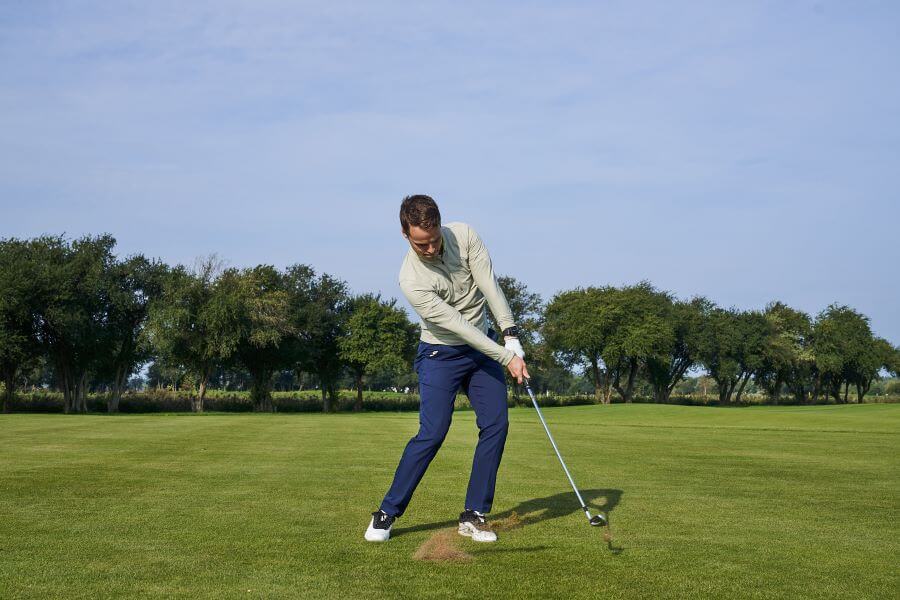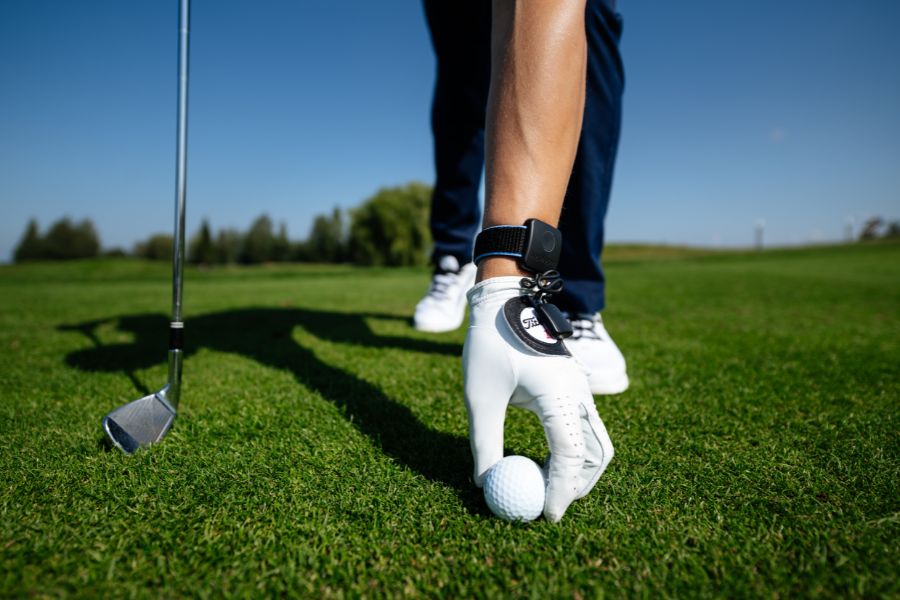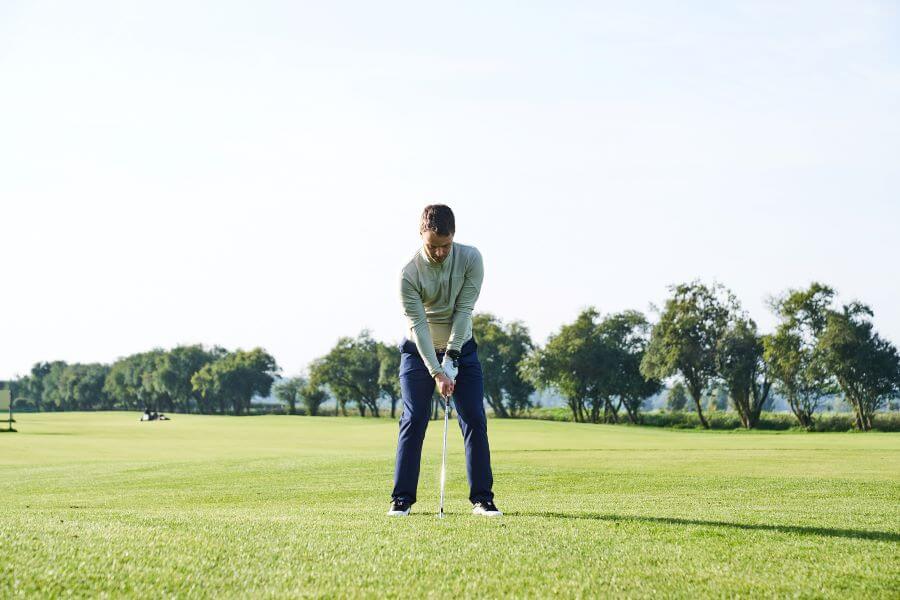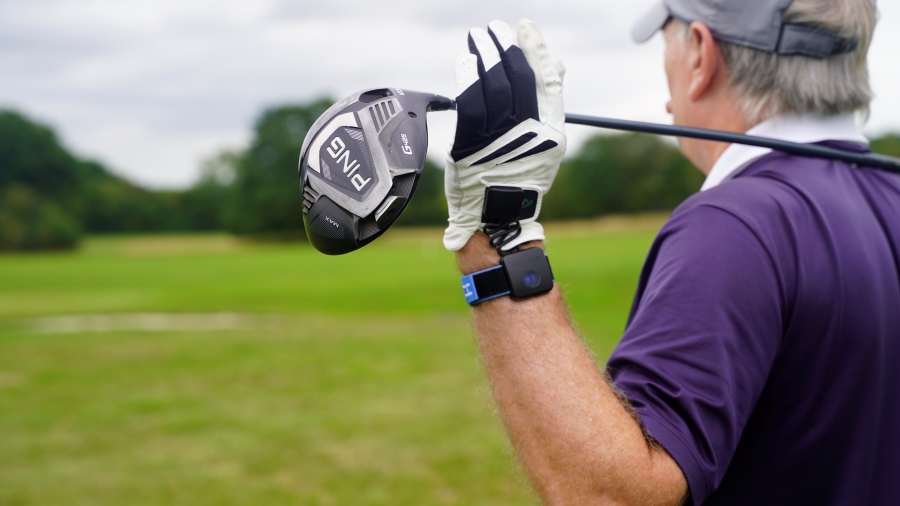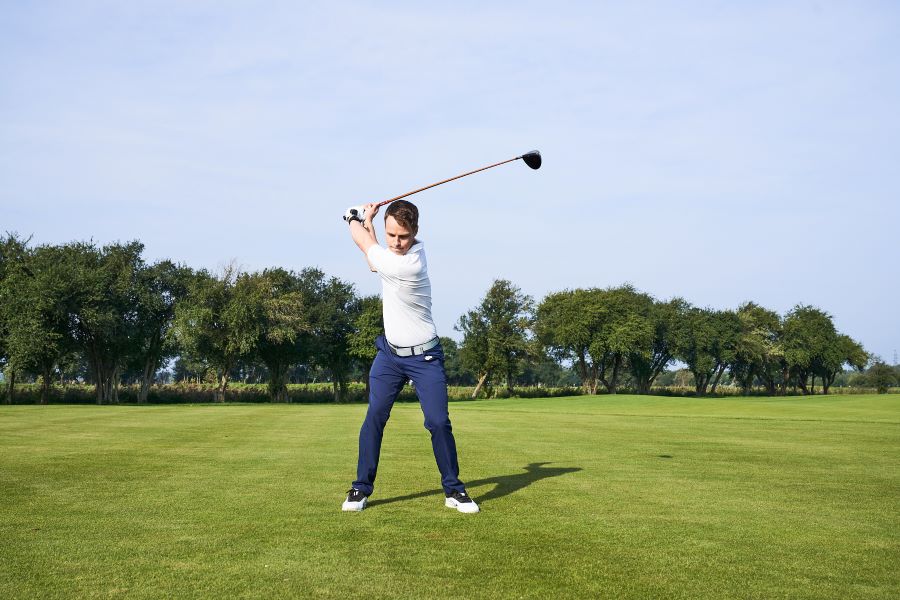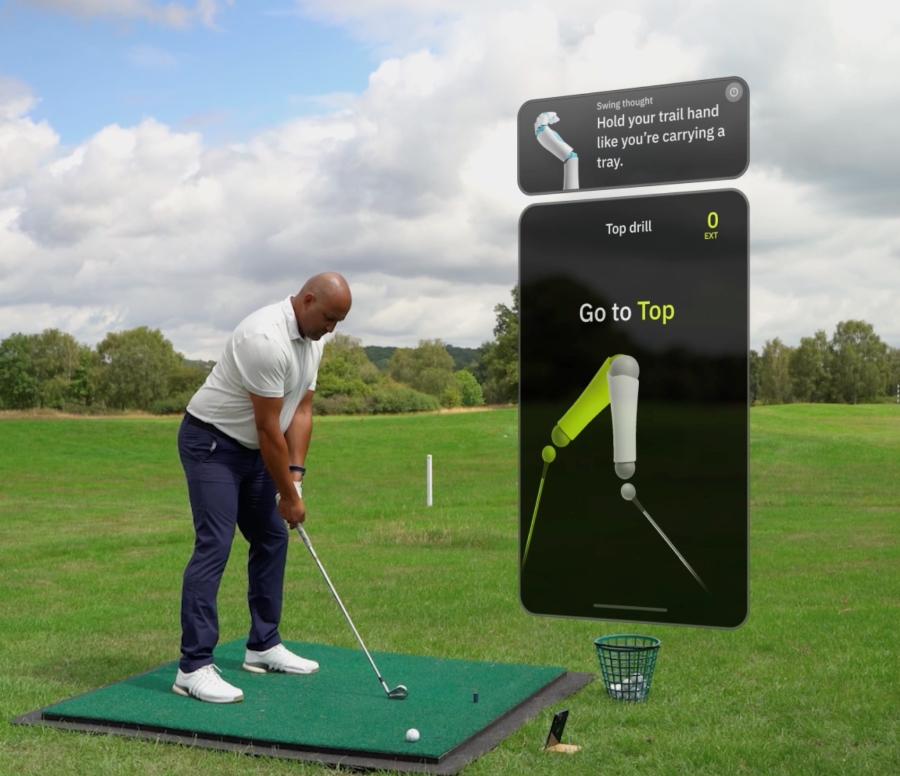Wedge Swing vs Iron Swing Explained – What Changes, What Stays the Same
When we talk about a full golf swing, the fundamentals should remain intact.
However, some details should be addressed regarding the differences between hitting your wedges and the rest of your irons.
The Wedge Swing vs The Iron Swing (Key Takeaways)
Don’t have time to read the entire article? Here are the key points to remember.
- The basic fundamentals remain the same for both wedges and the rest of your irons. But there are differences in the setup for wedges, including ball position, stance width, and center mass position.
- Wedges require a shorter, slower, and more controlled swing than your other irons, and the club itself has more bounce.
- Wedge and iron strategies differ; with wedges, you aim for more controlled swings and hitting it close to the flag. While with irons, you aim to hit the green.
Contents
Goals of Wedge Shots vs. Iron Shots
The wedges are your scoring clubs. Shots from roughly 100 yards and in make up 60% to 65% of all the shots you take in a round.
These are the tools that get you closer to your scoring goals quicker.
There is a misconception that exists in amateur golf as it relates to iron play. Many amateur golfers think that they need to hit many more greens in regulation than is necessary for their particular handicap. Or, more greens than required to get to a specific handicap level.
The reality is this.
The PGA Tour average for greens hit in regulation, a key stat driven by iron play, is roughly 65%.
This means that a Tour Professional, one of the best players on the planet, only hits 11-12 greens per round in regulation.
Let’s look at greens in regulation by handicap.
- 0 Handicap – 58.09% (~10.5 greens in regulation)
- 5 Handicap – 45.38% (~8.2 greens in regulation)
- 10 Handicap – 34.66% (~6.2 greens in regulation)
- 15 Handicap – 25.98% (~4.5 greens in regulation)
- 20 Handicap – 20.44% (~3.5 greens in regulation)
- 25 Handicap – 16.23% (~2.9 greens in regulation)
Your wedge shots, from those closer yardages, should be more of a focus as an amateur.
These clubs are the ones that more golfers will be able to hit the green with more often. And…hit it closer to the pin.
Wedge vs. Iron Strategy
Your strategy, especially with your wedges, should be to learn how to hit them solid, but in a way that you are swinging in a controlled and consistent manner.
Hitting the green, or as close as you can with your long and mid irons, is the goal and very welcome when it happens. It doesn’t matter what club you need to use to achieve that goal as long as you can do it in a non-harmful manner (i.e., don’t incur penalty strokes).
Proximity to the hole is more important with your shorter irons and wedges.
There is no need to try to hit those clubs for distance. It is all about proximity to the hole.
If you need to hit a PW over a 52-degree wedge, so be it. That does not matter in the big picture.
If you can hit your PW closer to the hole from 100 yards than your competitor, who is trying to muscle a 60-degree wedge, then you’ll win more often than not.
It is all about proximity to the hole with your wedges… not about how far one can hit them.
Similarities Between Wedge and Iron Swings
Some of the basics of the golf swing hold true throughout the bag. Whether you are hitting a wedge or a 4 iron, there are key components that should remain consistent.
Your Grip
Your grip is your body’s only connection to the club. With that in mind, it is important to have a good, consistent grip, both in hand position and pressure.
Making sure that the hands work together, with one not trying to overpower the other, is very important with your wedges and all of your other irons.
Your Wrists
Just as important as the grip itself is how the wrists work throughout the swing…for all shots.
As HackMotion shows us, the lead wrist has a direct correlation to what the face of the club is doing. We want to try to have the lead wrist flat at the top, or even slightly bowed at impact.
The Downswing
The sequence of events in the downswing should be as follows for both wedge and iron shots.
- Pressure Shift Into Lead Foot
- Hips Start to Unwind and Clear
- Chest Starts to Unwind
- Hands Narrow
- Club Falls Behind and Shallow’s
- Clubhead Moves into Ball at Impact with Proper Shaft Lean
- The body will slow down a bit, allowing the energy to transfer into the clubhead as it approaches impact.
This is all the same regardless of what club you are hitting.
Use the following drill to improve your wedge and full shot downswing.
- Video Timestamp: 4:10 – 5:00
- Quarter-fill a water bottle and hold it upside down in your trail hand.
- Go to the top using a normal backswing.
- “Pour” the water out as you transition. Rotate your trail forearm so that the water will pour out to the side (not over your head). This simulates shallowing the shaft.
- After a few rehearsals, replace the bottle with your club and aim for that same “pour” sensation.
- Do small, slow-motion downswings, similar to a wedge shot, then move into fuller swings.
Differences Between Wedge and Iron Swings
Most of the major differences between a wedge swing and an iron swing come in the setup.
Looking at how each club, from a long iron down to your highest lofted wedges, has a different loft, you need to set some pre-swing conditions up accordingly.
Ball Position
As the loft of your clubs increases, your ball position will move back in your stance. For standard shots, you would never want to go any further back than the center.
There are going to be cases where you can play around with that ball position if you want to hit it higher or a lower trajectory, for example.
Width of Stance
The width of your stance should be set in relation to the width of your shoulders. This takes into account the different body types of golfers.
- Driver: A step, with both feet, past shoulder width
- Woods, Hybrids, and Long Irons (3, 4): A half step, with both feet, past shoulder width
- Mid-Irons (5, 6, 7): Shoulder width
- Short-Irons (8, 9): Just inside of shoulder width
- Wedges: Half step, with both feet, inside of shoulder width
Center Mass Positioning
With your wedges, you will want to feel as though you have a little more weight set into your lead side.
Place 55% of your center mass into your lead side, and about 45% into your trail side for your most lofted wedges.
As you move up, from a 60-degree wedge to a PW, slide that feeling to about 52% on the lead side. With your 8 iron and up, you will have about a 50/50 distribution of your center mass.
Your long irons will keep your weight distribution the same, at 50/50; however, you will now introduce a touch of secondary spine tilt.
This is setting your spine back just a touch from being straight up and down. To achieve this, you will slightly bump your lead hip towards the target and move your upper torso back a touch towards your trail foot. You will still have your center set at about 50/50.
Wedge vs. Iron Swing Cues
The sequencing and the basic movement of the swing are the same. Where things differ slightly is in the length of the swing and the speed of the swing.
The Length of the Swing
The length of the clubs somewhat dictates the length of the swing. A 60-degree wedge is roughly 35” long, and a 4 iron is about 38.5” in length. The length alone does not dictate completely what the length of the swing will be.
The golfer can and does still control how far back they swing the club.
With wedges, there is really no need to swing back as far as you would with, say, a 4 iron. Wedge shots are more about control and accuracy—a shorter, more controlled swing aids in that.
Swing Speed
Much like with the length of the swing, the speed of the swing is going to be influenced by the club itself. Its length, weight, etc.
Swing speed with different clubs can be seen in the chart below from TrackMan. Again, the higher the loft on the clubs, the more they are built for accuracy and control.
| Club | Average PGA Tour Swing Speed | Average LPGA Tour Swing Speed |
|---|---|---|
| 4 iron | 96 | 80 |
| 5 iron | 94 | 79 |
| 6 iron | 92 | 78 |
| 7 iron | 90 | 76 |
| 8 iron | 87 | 74 |
| 9 iron | 85 | 72 |
| PW | 84 | 70 |
| GW | 83 | 69 |
| SW | 82 | 68 |
| LW | 79 | 67 |
Equipment Differences
Wedges and irons are constructed differently since they are intended to be used in different scenarios and in different ways.
Understanding how to take advantage of these differences will help you access their benefits more easily and avoid errant shots.
Which Clubs Have Bounce and What is it?
According to Titleist, Wedge Bounce is the angle created between the leading edge of the club and the lowest point of the sole. The greater the degrees of bounce, the higher the leading edge is off the surface at address.
This part of the club hits through the ground as it contacts the ball. All golfers have a few idiosyncrasies that make up their own unique game. How they come into the ball at impact, whether it’s a little steeper or a little shallower, will affect how they hit their irons, and especially, their wedges.
With wedges having more loft, the leading edge is more in the picture as the club comes into the ball at impact. That is where bounce comes in. It helps golfers make better contact on their wedge shots.
This is far less necessary with your other irons. PW to 3-iron has no bounce as the leading edge is needed more to connect with the ball.
Wedge and Iron Drills
These wedge and iron-specific drills will help you improve and recognize the differences between the two distinct subsets of your golf set.
Iron – Ruler Drill (Anti-Flip Drill)
Use this drill with Hackmotion to ensure your wrist action is optimized and helps you achieve the best results. It provides physical feedback.
- Video Timestamp: 4:10 – 5:00
Ruler Drill/Anti-Flip – Step by Step
- Slide a plastic ruler (or similar stiff card) inside your glove, running along the back of your lead wrist.
- If you set up with too much wrist extension, you’ll likely feel slight pressure from the ruler against your forearm.
- As you swing halfway back, focus on “removing” that pressure by flattening or gently bowing the lead wrist.
- Maintain that flatter (or slightly flexed) wrist feel—don’t let the ruler dig into your forearm.
- Let the muscle memory build. Keep the ruler off your arm through impact; you’ll eliminate flipping and improve low-point control. Wearing your HackMotion can help you tie some data to this and ensure you create a repeatable backswing.
Wedge – Body Connection Drill
Many recreational golfers try hitting delicate shots with only their arms and a quiet body. To find success with wedges, the opposite approach is needed.
Use this drill on the range to activate your body and limit the use of your arm strength to control distance.
- Video Timestamp: 1:52 – 2:39
Body Connection Drill – Step by Step
- Place a small ball/towel between your forearms and take your chipping setup.
- Make short chips while lightly squeezing the object so it stays in place.
- Let the torso start the motion; keep wrists quiet and elbows connected.
- Aim to brush the turf; avoid digging or flipping.
- Remove the ball and retain the same connected feel on regular chips.
Final Thoughts
As you can see, there are many differences between your wedges and the rest of your irons. Your wedges are more for scoring and accuracy, much more so than your other irons.
It is a given that as your distance from the hole increases, your probability of hitting it close to the pin decreases. This is why your wedges are of great importance.
Using the tips and drills above is the first step to improving both aspects of your game. If you’re using Hackmotion as well, then you’re ahead of the game.
The technology in the Hackmotion system is designed to help all aspects of your game. The easy-to-use app will track your movements and make personalized drill suggestions so you can work on the parts of your game that need it most.






